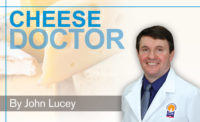Fortification is nothing new for the dairy industry. In fact, one of the most well-known examples of beneficial food fortification is the addition of Vitamin D to milk.
Vitamin D fortification of milk helped eradicate rickets as a serious health problem in the United States. As a result, Vitamin D is now synonymous with the dairy industry.
Milk was an excellent choice for fortification since it was so commonly consumed by children. Over the years there has been a continued interest in fortifying products for health benefits and also as a means to differentiate a product from the competition. In some cases, fortification has been successful, increasing sales and helping to curb some nutrient deficiencies. But in many cases, fortification can be costly, and without consumer support or interest, sales can falter.
The challenge of stability
One of the challenges companies face in creating fortified food products is the stability and viability of the nutrients in the food matrix. For example, cheese is a “living” product that has ongoing physical and chemical changes due to residual microbial and enzymatic activity. The low pH, high salt and minimal sugar (carbohydrate source) in cheese can make it difficult to maintain the viability of some added bacteria, such as probiotics. Careful selection of probiotic bacteria is needed to make sure they remain at high numbers throughout the long storage required for many types of cheese. Another alternative is to encapsulate the sensitive bacteria, but this adds significantly to the manufacturing costs.
How to add a nutrient to cheese is another question. If added to the milk, then how much is lost in the whey (which might concern the whey processor)? Adding the nutrient directly to the curd is commonly practiced but sometimes it is difficult to evenly distribute the component throughout the curd.
At the moment, one of the most popular additions to cheese is omega-3s. These fatty acids offer many potential health benefits (for example, lowering heart disease risk or improving cogitative function). Still, fortifying cheese with omega-3 also comes with potential challenges including a fishy, oxidized flavor and breakdown of the acid. Thankfully, sources of omega-3 are now available that are suitable for fortification.
One common issue for any attempt at fortification, however, is whether the consumers will accept enrichment of the food with a specific nutrient or will it only confuse them. This has been an issue with probiotics and omega-3 fortification in cheeses because consumers associate those nutrients more with yogurt and fish products, respectively.
Are added nutrients necessary?
Additionally, many Americans may already be getting most of the necessary vitamins and minerals in their diets, curbing interest in fortified products. For example, in the “Second National Report on Biochemical Indicators of Diet and Nutrition in the U.S. Population,” the study states that between 2003 and 2006, “10% or less of the general U.S. population had nutrition deficiencies for selected indicators,” which included iron and Vitamins A, D and E, among others. Thus, nutrient fortification might not be needed for the entire population but there are specific age and ethnic groups that have higher rates of nutrient deficiencies, which could be addressed by new product innovations.
Another challenge cheesemakers may face in fortifying products with nutrients like omega-3 are the labelling rules surrounding content claims like “excellent source.”
Benefits from bio-active peptides
Despite some of these challenges, an interesting opportunity for cheese is the presence of peptides that have “bioactivity,” meaning that they have some biological activity (beyond providing nutrients). During cheese aging, milk proteins are broken down into small peptides by enzymes from milk, rennet or starter cultures. The beneficial health effects derived from these peptides may be classified as anti-microbial, anti-oxidative, anti-hypertensive and immunomodulatory.
Aged cheeses are naturally rich in bioactive peptides due to their extensive protein break-down. For example, in some recent work at UW-Madison, it was estimated that there may be a potential anti-hypertensive effect observed if high blood pressure subjects consume more than 100 grams (3.5 ounces) per day of a particular brand of 1-year Cheddar cheese (due to its high content of anti-hypertensive tripeptides). Considerable work would be needed, including clinical trials, before any label claims could be made, but this is an exciting area of study.
Fortification offers manufacturers an opportunity to improve the nutritional content of their product and perhaps even create a niche in the market. Perhaps someday bioactive peptides and cheese might be as synonymous as probiotic bacteria and yogurt.




